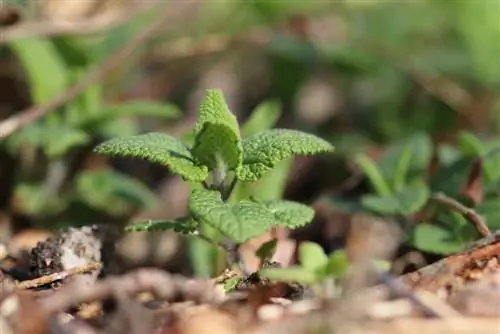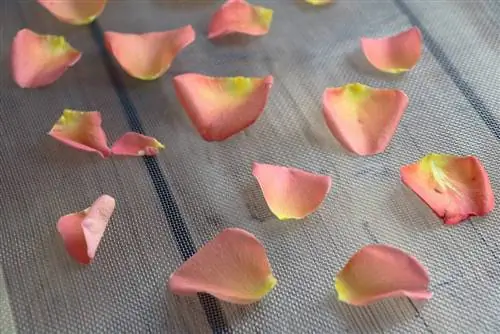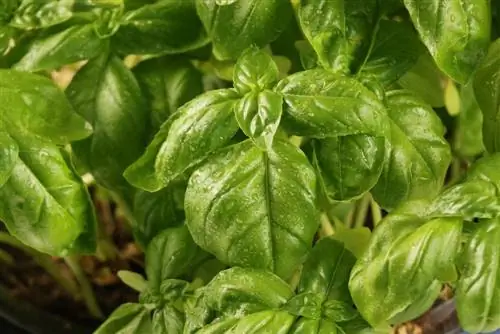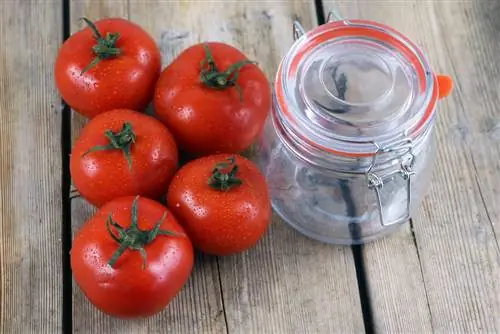- Author admin [email protected].
- Public 2023-12-17 03:39.
- Last modified 2025-01-24 12:45.
There is a lot of goodness for us humans in the silver-green leaves of the sage. The intense aroma gives our dishes a touch of spice. Its essential oils are extremely healing: a sage tea soothes a sore throat in a gentle, natural way. Unfortunately, it can only be harvested fresh in the garden in summer. But thanks to gentle drying, sage is available to us all year round.
Preserving sage
Sage thrives in our home gardens. Over the years it can develop into an attractive shrub that sprouts plenty of green leaves in summer. Sage that is freshly harvested and then processed immediately tastes best and contains a lot of essential oils. But after flowering, the amount of essential oils decreases and the harvest is over with the first frosts. So that sage doesn't disappear from our diet for months, you can easily use the abundance of leaves to create a dry supply for the winter. Its beneficial effects as a tea are especially needed when your throat hurts and calls for relief. Sage can be frozen to preserve it, but drying is more beneficial. This means the sage retains its flavor longer than if it were frozen. There are several options for drying:
- in the air
- in the oven
- in the microwave
- in the dehydrator
Harvest fresh sage
The essential oils are what makes sage special. They provide the desired flavor in food and have a healing effect in natural medicine. It is therefore important to preserve as much of it as possible in the dried leaves. In order for this to be successful, the freshly picked leaves should contain as many essential oils as possible. The correct harvest time is particularly important here, because their concentration is not consistently high.
- Use leaves with lots of essential oils
- Aroma content in the leaves varies
- it is highest a few days before flowering
- therefore the ideal harvest time is the beginning of summer to mid-summer
- Picking leaves in front of the midday sun
- use sharp secateurs or a clean knife
- Snip off the tips of the shoots or entire branches straight
- Flowers are not suitable for use
Tip:
Shower the bush gently with water the evening before harvest. The leaves become clean and still have time to get rid of the moisture before harvest.
Clean sage thoroughly
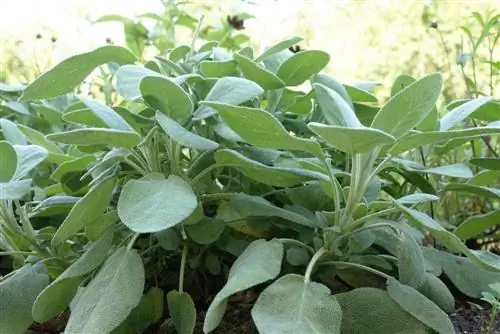
If the sage is cleaned with water immediately before further processing, it will have a harder time drying. However, sometimes there is no way around it. Especially when it is growing outdoors, when wild sage is picked, or when animals may have come into contact with it, it needs to be washed.
- whenever possible, rinse off the evening before harvest
- otherwise wash before drying
- Rinse the leaves briefly
- use cold to lukewarm water
- Carefully pat the leaves dry with kitchen paper
- Sort out leaves with spots and wilted parts
Note:
Freshly harvested and cleaned sage should be processed or dried as quickly as possible. Long storage has a negative effect on the later taste.
Preserving sage in the air
Sage branches that hang in the air gradually lose their moisture until they are finally completely dry. This is a simple method of preserving sage that requires nothing more than sage and a little patience. However, since this type of drying takes some time, the sage loses some of its essential oils.
- Tie shoots together with thread
- to make bouquets with 6 to 10 branches each
- hang upside down
- dark and dry room is ideal
- alternatively: place individual sheets on newspaper
- Drying takes about 1 to 2 weeks
- Drying time depends on the weather
- then store sage in a container
Tip:
The room in which the sage was hung to dry should be ventilated regularly. This allows the moisture to escape and the sage to dry safely without becoming moldy.
Remove the moisture in the oven
Sage can be transformed into a storable herb in an oven more quickly than in air. The whole process is completed within a day and the sage is completely dried. This preserves more aromatic substances than when drying in the air.
- Harvest the sage fresh. The fresher the leaves are, the more essential oils they contain.
- Clean the sage with lukewarm water if necessary.
- Then carefully pat the leaves dry with a kitchen paper towel.
- Heat the oven to 40 to 50 degrees fan.
- Line a baking tray with baking paper.
- Spread the sage leaves onto the baking paper without letting the individual leaves touch each other.
- The baking tray can now go into the oven.
- Leave the oven door slightly open to allow moisture to escape.
- The leaves should be turned by hand about every 30 minutes.
- After about 6 to 8 hours the leaves will be completely dry.
- Rub a few leaves between your fingers. If they rustle and crumble, the sage is really dry.
- Let the sage cool completely.
- 1Place the cooled sage in a suitable screw-top container.
Tip:
Be patient until the optimal harvest time is just before flowering, when the essential oil content is highest. You will be rewarded with a more intense aroma and higher healing power.
Quick drying in the microwave
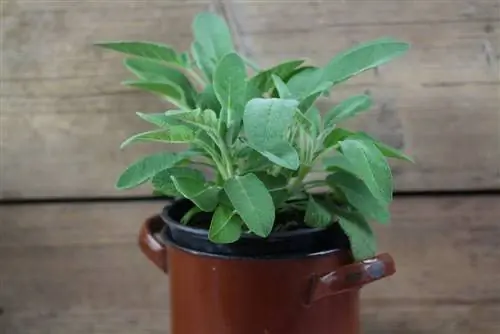
If you're in a hurry and have a microwave, you can also preserve the sage this way. It is one of the few types of herbs that can be dried in the microwave. The process is similar to that in the oven, except that everything happens at a rapid pace typical of microwaves. However, the speed also has a disadvantage: the intensive treatment leads to a loss of aromatic substances. Sage dried in the microwave is therefore ideal for dry arrangements or as smoking material.
- Prepare the freshly harvested sage for drying by rinsing it with lukewarm water and then patting it dry with a kitchen towel.
- Cut a piece of baking paper suitable for the microwave and line it with it.
- Spread the sage leaves on top without touching the individual leaves. Alternatively, you can place the leaves in a microwave-safe container.
- Set your microwave to 150 to 200 watts and start it for about 10 to 20 seconds.
- Then open the microwave door to allow the moisture to escape.
- Check how far the sage has dried.
- If the sage is still wet, turn the leaves over and start another 10 second pass.
- Repeat the drying process until the sage is completely dry.
Tip:
Wait for the sage to cool before putting it in a dark glass. If the sage is still warm, condensation can form and affect its shelf life.
Preserving sage in the dehydrator
If you have a dehydrator, you can preserve sage particularly easily and conveniently. Purchasing a new dehydrator can also be worthwhile, especially if the garden produces a large harvest of vegetables, fruit and herbs. An automatic dehydrator is suitable for preserving many garden products. This method works like an oven in that warm air flows around several sieve trays. However, an automatic dehydrator is particularly energy-saving compared to an oven. This also means the oven is not blocked for many hours.
- Pick the sage fresh and before the midday sun can shine on the bush.
- Clean the leaves under running water to rinse away any impurities.
- Wet sage takes longer to dry, so gently pat it dry before placing it in the dehydrator.
- Distribute the sage leaves over the bottom of the sieve, leaving about 20% of the area free.
- Remove unneeded screens. There must not be any other plant parts in the dehydrator during the drying process.
- Turn the dehydrator on to the degree recommended in the instructions for use.
- The drying process should be finished after about 6 to 7 hours. The leaves should still be slightly green and flexible.
Store dried sage properly

So that the sage retains its aroma for a long time and is therefore useful to you, it should be stored properly after drying. An optimally stored sage retains its essential oils and therefore its taste and healing effects for a long time.
- Sage must be completely dry
- Store properly immediately after drying is complete
- use a suitable storage container
- airtight glass is ideal
- store in a cool and dry place
- Container is labeled with name and date
- Shelf life depends on storage conditions
- if stored appropriately, it will last about 2 years
Note:
If sage is stored when it is not completely dry, mold may form. A dryness test should therefore be carried out before storage. If the leaves rustle and crumble when touched, the sage is dry.
Important information
In addition to many welcome substances, sage also contains toxic thujone. Sage-based medicines are therefore not suitable for long-term use. This also applies to sage tea. In the kitchen, however, sage can be used safely to season dishes because the dose used is small.

